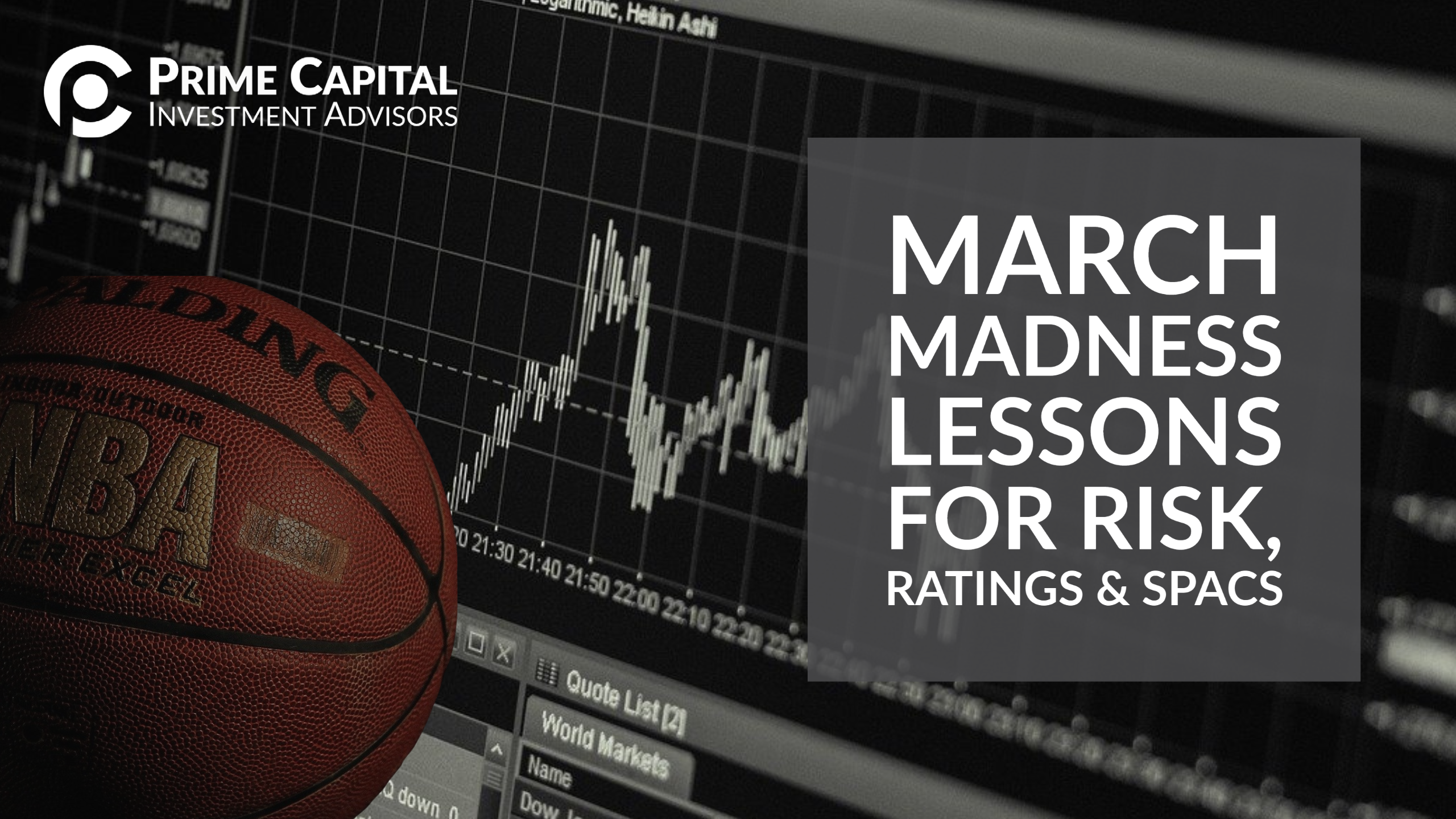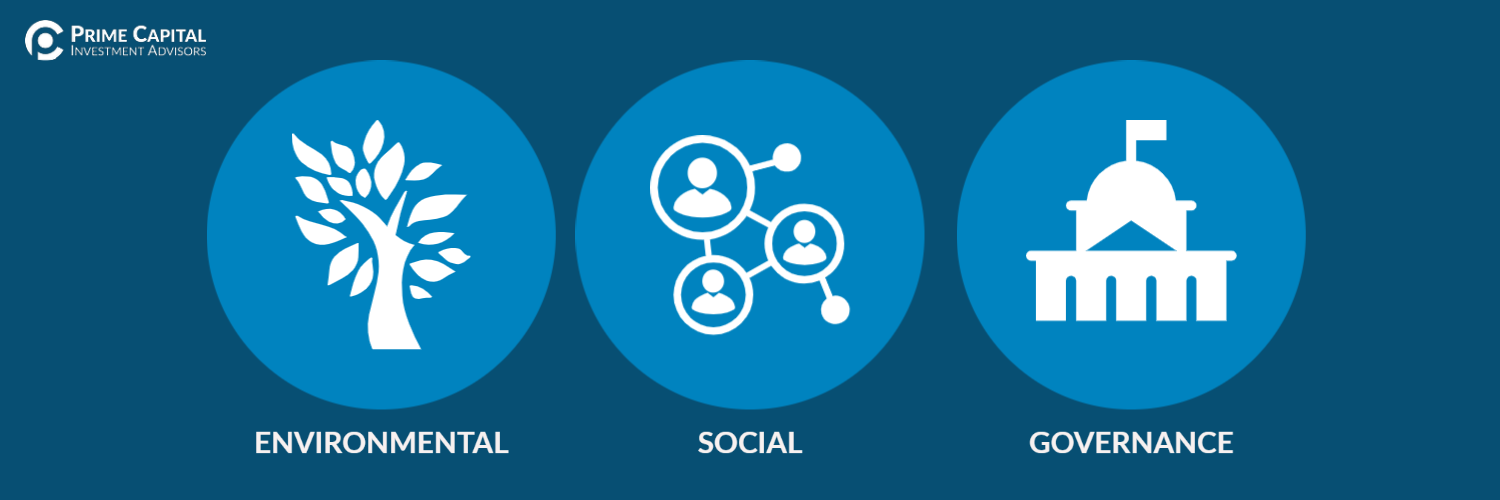As the month went on, the volatility continued, but risk assets went on a final run towards the end of the month with almost all asset classes ending in the green for May. Check out the latest Month in Review.
Wendy Prestwood Joins Prime Capital Investment Advisors
PCIA is pleased to announce Wendy Prestwood, CMFC, CRPC, has joined the firm as Partner and Wealth Advisor. She has 25 years of experience in the industry and is based out of the Overland Park, KS office.
March Madness Lessons for Risk, Ratings, and SPACS

March is the time of year when almost everyone becomes a basketball fan — cheering on teams, participating in office bracket challenges, and feverishly following basketball underdog stories. So, the ‘madness’ also makes for a great opportunity to help explain some investing do’s and don’ts.
Opening Tip: Emotions Won’t Help You Win
I’ve written about the parallels between March Madness and investing before, but given how volatile the financial markets have been this past year, there’s more to expand upon. Emotional investing – based on fear, greed or some other reason – can cost an investor dearly. Starting in March 2020 when there was a huge sell-off in the market and volatility was at all-time highs, there were a lot of knee-jerk reactions and emotional investing. But emotional investing only negatively impacts a long-term investing strategy. People who stayed the course with their long-term strategy were rewarded with gains this past year.
When strategizing for your team or portfolio, picking blue blood teams to win your bracket or blue-chip stocks for your portfolio, are typically safe bets. But as we all know from this pandemic-stricken year, who and what truly defines safe is not guaranteed, and sometimes changing strategy is necessary.
Pivot
Duke and Kentucky, two of the most well-known blue blood basketball teams, did not make the tournament this year. And another well-known blue blood, UNC, is seeded lower than we’re used to seeing. In the markets, the big tech names like Apple, Amazon, Google and Microsoft, may not be where you want to allocate all your money right now either. We’re seeing a rotation out of technology, and this year may be the year you need to find other investments to help carry your portfolio, like high quality companies found in more cyclical sectors like financials, industrials, materials, and even energy. Just like you’ll have to find other teams to carry your bracket, such as more blue-collar teams like the Gonzaga Bulldogs, Villanova Wildcats, or even the Baylor Bears. While many topics from my previous March Madness blog still hold true, some things have changed, like a rotation out of tech, fallen angels and Special Purpose Acquisition Companies (SPAC). So, here’s how this year’s hot investing topics correlate to the madness of the single-elimination college basketball tournament.
Boom or Bust
In the past ten years, bracket participants are getting bolder. Every year more and more people are picking 16 seeds to upset 1 seeds in their brackets, which has only happened once in the history of the tournament. So picking 16 seeds to upset 1 seeds can very easily bust your bracket, just like buying a bankrupt and/or junk rated stock can very easily bust your investment portfolio. We saw this pandemonium play out recently with retail trading activity surrounding Hertz last year, and the ‘Reddit Revolution’ and frenzy around stocks like GameStop and AMC; some made a lot of money, others lost a lot. Building an investment philosophy around buying bankrupt stocks is not a sound principle, just like picking 16 seeds to upset one seeds to build your tournament bracket.
Instead of hoping for the slam dunk, picking the 12 and 11 seed upsets in your bracket is more calculated and similar to investing in a company that may not be profitable quite yet, but perhaps will be in the future. An example of calculated risks would be tactically overweighting asset classes in your portfolio relative to their long-term targets, to capitalize on the current and future expected market environment, such as overweighting small cap stocks, overweighting international equities (primarily emerging market equities). Historically, during the early phases of recovery, expansion, and reflationary periods, certain areas and asset classes tend to perform better as they capitalize on improving global growth and expansion. Because these asset classes typically carry higher levels of volatility or risk, making minor tactical changes to your long-term targets could be seen as calculated, despite exposing more of your portfolio to riskier asset classes over the short term. Other examples of calculated risks in the investment world might include renewable energy and Electric Vehicle (EV) companies. Just because they aren’t profitable right now, doesn’t mean they aren’t a good long-term investment. You have to be willing to accept the short-term volatility, as there are themes taking shape right now that will play out longer-term. The key, just like picking the right 12 and 11 seed upsets, is to spend time getting to know those companies and how they may benefit from trends just now starting to form.
SPAC Attack and Fallen Angels
Everyone loves a Cinderella team during the tournament because they have a great story that gets a lot of media attention and support from the masses. Special Purpose Acquisition Companies (SPACs) are an investment hot topic in financial media these days. With more than $80 billion being invested in U.S. SPACs in 2020, investors like Shaquille O’Neal, Steph Curry, Serena Williams and a number of others are buying in. But there’s still caution to be had because SPACs don’t have the same regulatory process as other companies going public through IPOs. With the level of risks accompanying SPACS, you don’t want to put all your money in one basket. If you’re going to invest in them, proceed with caution and look to make SPACs a very small portion of your portfolio, just like you would make a potential Cinderella team, a small portion of your bracket.
Building a team or portfolio strictly based upon rankings, has the potential for diminishing your long-term success, as we’ve witnessed this past year with bonds. If you build out your bracket just by looking at the NET and KenPom rankings of teams, your long-term success is going to be diminished. The same goes for picking bonds for your portfolio. The market witnessed a lot of ‘investment grade’ BBB-rated bonds downgraded to junk bond status as their credit ratings took a hit during the heart of the pandemic shutdown, making them ‘fallen angels’. Focusing solely a bond’s rating could lead you to adding bonds of companies on the brink of credit downgrades, which could cause you to experience large losses on what are perceived safer investments – ‘investment grade’ bonds. Conversely, fallen angels present attractive buying opportunities for high yield, or junk bond, managers; allowing them to add higher quality junk bonds to their portfolios, often at a discount. Given the amount of credit downgrades we witnessed in 2020, it’s no wonder about 50% of the junk bond market is now rated BB.
Ratings can often be misleading and adding, or even excluding, securities solely based on their ratings could lead to portfolio losses or missed opportunities. The same way picking your bracket based solely on the lowest rankings (NET or KenPom – lower is associated with being better) or seeding could leave your bracket susceptible to the ‘fallen angels’ of the tournament, those that were ranked highly, only to be upset in the first round, or even the round of 32. Conversely, identifying the pre-tournament ‘fallen angels’, or those that may have suffered a couple of losses leading up to the tournament, causing in their rankings to fall, could prove to be high-quality tournament teams that could result in some upset victories. In investing and basketball, it’s best to look beyond just ratings and rankings and think about the sum of all of the parts. Balance is key.
Throughout the tournament’s history, there has only been one Final Four where all top four seeds made it to the final, so why construct your bracket just with top seeds? A better predictor is the sum of your teams’ rankings. Typically, the sum of the Final Four teams tends to be between 8-11, so you’ll need some lower seeded teams for your bracket’s Final Four. Put this into the context of the bonds in your portfolio. If you’re aiming for an A average, you’ll want a mix of AAA and AA bonds (which can be viewed as the one and two seeds), BBB bonds (like a 4 or 5 seed), and some junk bonds (the 7 seeds or lower). By sprinkling in some bonds that have lower ratings, you give yourself the opportunity for higher yield while also maintaining some safety. Again, the key is balance.
It’s important to remember that investing should be done for the long-term. And while it’s fun to compare investing to basketball, March Madness only lasts a few weeks. You want your money to last for decades. Making smart, prudent choices for a long-term investing strategy is always the best bet. Remember, that if you’re going to include risk, you need to make sure it’s calculated and that the juice is worth the squeeze. Consider working with a trusted advisor who can help you take the emotion out of investing. Here are some tips for picking the right advisor for you.
Disclosures: The preceding commentaries are (1) the opinions of Chris Osmond and not necessarily the opinions of PCIA, (2) are for informational purposes only, and (3) should not be construed or acted upon as individualized investment advice. Investing involves risk. Depending on the types of investments, there may be varying degrees of risk. Investors should be prepared to bear loss, including total loss of principal. Past performance is no guarantee of future results. Advisory services offered through Prime Capital Investment Advisors, LLC (“PCIA”), a federally registered investment adviser. PCIA: 6201 College Blvd., 7th Floor, Overland Park, KS 66211. PCIA doing business as Prime Capital Wealth Management (“PCWM”) and Qualified Plan Advisors (“QPA”)
Should You Consult a Financial Advisor Before Buying a Home?

March is the peak season for house listings, which means that you, as a buyer, might be thinking about what your next step is for your living situation. This big decision could likely impact your life for years to come. It may warrant the question, “Should I consult a financial advisor before buying a home?”
Though you may have already gotten advice from your real estate agent and mortgage broker, they’re not prioritizing your complete financial situation. A financial advisor will take a comprehensive look at your entire situation before giving you advice.
- A good advisor will help you build a strong financial plan to manage your current debt, giving you tips on how to budget and pay off loans, prior to looking at real estate.
- A good advisor will help you start the conversation by asking you important questions before you buy a home such as:
-What are your long and short-term goals? Knowing this will help you know how the home fits in.
-Will you be able to make a decent down payment? (10 to 20% down) Your down payment will impact your budget and more than likely your savings.
-What is your contingency plan if your job or family situation changes soon after buying a home? - After you’ve bought a home and have lived there a couple months, you’ll get a better sense of your actual budget, which may include items you forgot to factor in. Your financial advisor will be there to help you readjust your budget for unaccounted costs, while also monitoring the rest of your financial goals.
Our team at PCIA provide a wide range of products and services to meet the expanding needs of each individual client. Our financial experts are passionate about applying their knowledge and expertise to help you reach for your financial goals. To get started, you can contact us at https://pciawealth.com/contact-us/.
March Top Advisor by Participant Outcomes (TAPO)—Chris Roper
A Soul Search for Successful Outcomes
FOR WELL OVER A DECADE, Chris Roper has helped people from all walks of life plan and save for retirement. But something changed in 2019. For the first time, Roper, a Partner and Plan Success Consultant with Overland Park, Kansas-based Qualified Plan Advisors, took an eye-opening trip through Southeast Asia.
Traveling alone gave him time to reflect on his true passion: the personal interactions from working with employees to improve their financial health. He concluded “doing well by doing good” mattered most, and he re-emphasized his singular vision of eventually helping over a million people improve their financial lives.
With his goal and passion aligned, he returned home and hit the ground running. Joining Qualified Plan Advisors (QPA), he benefited from Scott Colangelo, Matthew Eickman, and other high-profile QPA team members’ expertise to consistently improve participant outcomes.
His passion and excitement are palpable.
“The core of our company is to ‘inspire people to achieve their life’s ambitions,’ and we believe that communicating the right information and showing that you care helps people to make better financial decisions,” he said.
The initial keys to a participant’s successful retirement outcome are (1) getting them in the right investment; and (2) getting them to save appropriately. While auto features can be a great option, he believes that helping people make an active decision gives them ownership in their success, which will lead to better outcomes.
“They’re more likely to stay invested when the market drops,” Roper added. “This helps counteract the bad behavior of selling low. It helps remove the fear of investing and opens them up to saving at higher levels.”
Roper also utilizes Aon Hewitt’s “The Real Deal” study to help participants understand how much they should be saving. It gives them a target savings rate that, unfortunately, most have never heard of and acts as a needed wake-up call to get them back on track. Far from a 3% default or even more commonly seen 6%, it’s much higher.
“Most people are shocked when they hear that a 25-year-old retiring at age 67 needs to save 16% of their pay, including company contributions,” he explained. “My careful delivery of this message helps participants to make decisions that will ultimately improve their financial futures.”
He recently faced a difficult challenge while planning employee education sessions for a new client. Roper spent four weeks meeting with employees in office locations spread over four states.
He conducted 79 group meetings and logged over 3,000 miles of drive time. It was well worth it. With the help of his QPA team members, he was able to achieve the following results:
• 588 participants in attendance
• 574 made an active decision for their investments and deferrals
• 148 one-on-one meetings were conducted
• 360 participants elected a portion of their contribution to a Roth savings account
• 394 participants saved above the company match
As one would imagine, Roper is extremely proud of getting over 97% of participants to make
an active decision and getting 67% of participants to choose to save above the already generous company match.
See the article on 401(k) Specialist.
The Basics of ESG Investing
Investment choices made based on environmental, social, and governance (ESG) factors are becoming exponentially popular.
Prime Capital Investment Advisors Acquires 20/20 Financial Advisers and Financial Network Limited
(PCIA) is pleased to announce the acquisitions of 20/20 Financial Advisers and Financial Network Limited.
Prime Capital Investment Advisors Announces New Leadership In Cedar Rapids Office
(PCIA) announces new leadership in its Cedar Rapids location and its continued commitment to this very important market.
How Well Do You Know the Stock Market?
Today, there are more Americans investing in the stock market everyday. Those invested in the stock market include savvy veterans who have studied the market for decades, as well as beginners who are trying to learn the ropes. A survey conducted by Bankrate found that 39% of Americans have no money invested in the stock market. Of those people, 32% stated that their main reason for not investing in stocks is their lack of understanding.
Where does your stock market knowledge stack up against the average investor? Take the quiz below to find out!
Advisory products and services offered by Investment Adviser Representatives through Prime Capital Investment Advisors, LLC (“PCIA”), a federally registered investment adviser. PCIA: 6201 College Blvd., Suite #150, Overland Park, KS 66211. PCIA doing business as Prime Capital Wealth Management (“PCWM”) and Qualified Plan Advisors (“QPA”).
The Three Alternative Investments You Should Research Right Now
There is a current euphoria taking place in the public markets, but if you look forward it seems as though we are borrowing from future returns. Many financial institutions and analysts are projecting lower returns for both U.S. equities and U.S. bonds moving forward, and more broadly across major asset classes. Higher inflation levels are expected in the future as well, and with those higher levels, it’s going to be difficult to find places in the public markets that provide a good return without losing purchasing power.
This is why, for the right investor, alternative investments can really add value to a portfolio today. We look at incorporating alternatives into a person’s portfolio to enhance diversification and improve the risk-reward profile. Said differently, for the same level of risk, alternative investments help us to create portfolios that have a better expected return. But just like most things in life, not all alternative investments are created equally. We like the core, foundational alternatives: private equity, private real estate and private credit. Let’s explore each a little further.
Private Equity
There is tremendous opportunity in private equity. 80 percent of the companies in the United States with sales greater than $100 million are private companies. Now compare that to the shrinking opportunity set in public markets. In the 1990s, there were about 8,000 publicly listed companies in the U.S. but that number is now just under 4,000, meaning the opportunities there have decreased dramatically.
You’ll also see the opportunity in private equity if you look at the overall market cap. The average size of private companies is smaller than public companies, meaning they have more room to grow. And if they have more room to grow, that’s a growth opportunity for the investor.
When you’re looking for returns that are larger than what public markets have offered, private equity offers a huge opportunity partly because of the liquidity premium. Simply put, if you’re going to put your money in something that is difficult to get it out of, you can expect greater returns for that inconvenience.
Now is a great time to explore an investment in private equity because there’s been an amazing evolution in the vehicles and structures that investors now have at their disposal. It used to be that your only option for investing in private equity meant your capital would be locked up for 7-8 years before you’d see a return of your capital. These days, many new investments provide quarterly liquidity opportunities, which provides far greater flexibility for investors.
Private Real Estate
Real estate is a major contributing factor to consumer net worth, which makes these hard assets a great wealth accumulation vehicle. As I look at the current environment, investments in private real estate make even more sense because they serve as a natural inflationary hedge. As interest rates go up, lease rates go up. Landlords are able to pass along rising rates, instead of suffering from them.
Many private real estate investments are also very tax efficient, between the usage of depreciation, taxed deferred growth, and even 1031 exchanges that can allow investors to roll gains from one property or offering forward to another without having to recognize the capital gain at the time of the transaction
Finally, real estate doesn’t necessarily need to be confined to one particular sector. Many people think of retail stores, office buildings, or apartments when they think of this asset class, but other segments such as data centers, industrial warehouses, and even cell phone towers also provide access to secular growth trends in the economy.
Private Credit
For investors who need income ,where can they get it in this current low interest rate environment?
With private credit, you’re also able to extend to other areas of fixed income that you can’t touch in the public markets. For example, collateralized loan obligations or CLOs offer shorter duration fixed income exposure for your portfolio, which helps to limit interest rate risk. If you can get your money returned to you quicker, you face less risk from inflation lessening your purchasing power. Private lending can also offer higher rates of income for the same level of credit risk, again due to the illiquidity premium that is typically associated with these types of products.
Implementation
As we have noted, alternative investments can provide a significant diversification benefit as well as inflationary protection for an investor’s portfolio. But they also help instill better investor behavior. This was evident in March 2020 when the market crashed at the start of the pandemic. Alternative investments are often harder to pull one’s money out of in a hurry, so instead of panic selling, investors stay in and reap the benefits of the recovery.
Today’s environment calls for outside-the-box thinking for investors hoping to achieve healthy returns while maintaining a reasonable level of risk. There is by no means a perfect solution for everyone, and there could be some additional requirements necessary to participate in these types of investments so they must be used carefully, only as a satellite option to complement, rather than replace, a traditional investment portfolio. Because reporting requirements are not as stringent as those for publicly traded securities, a thorough due-diligence process is an absolute necessity before investing, and on an ongoing basis for monitoring purposes. This is where having a research team on your side can be incredibly helpful. If you have questions about alternative investments and how they can best be incorporated into your portfolio, don’t hesitate to reach out to us here at Prime Capital Investment Advisors.
Advisory products and services offered by Investment Adviser Representatives through Prime Capital Investment Advisors, LLC (“PCIA”), a federally registered investment adviser. PCIA: 6201 College Blvd., 7th Floor, Overland Park, KS 66211. PCIA doing business as Prime Capital Wealth Management (“PCWM”) and Qualified Plan Advisors (“QPA”








